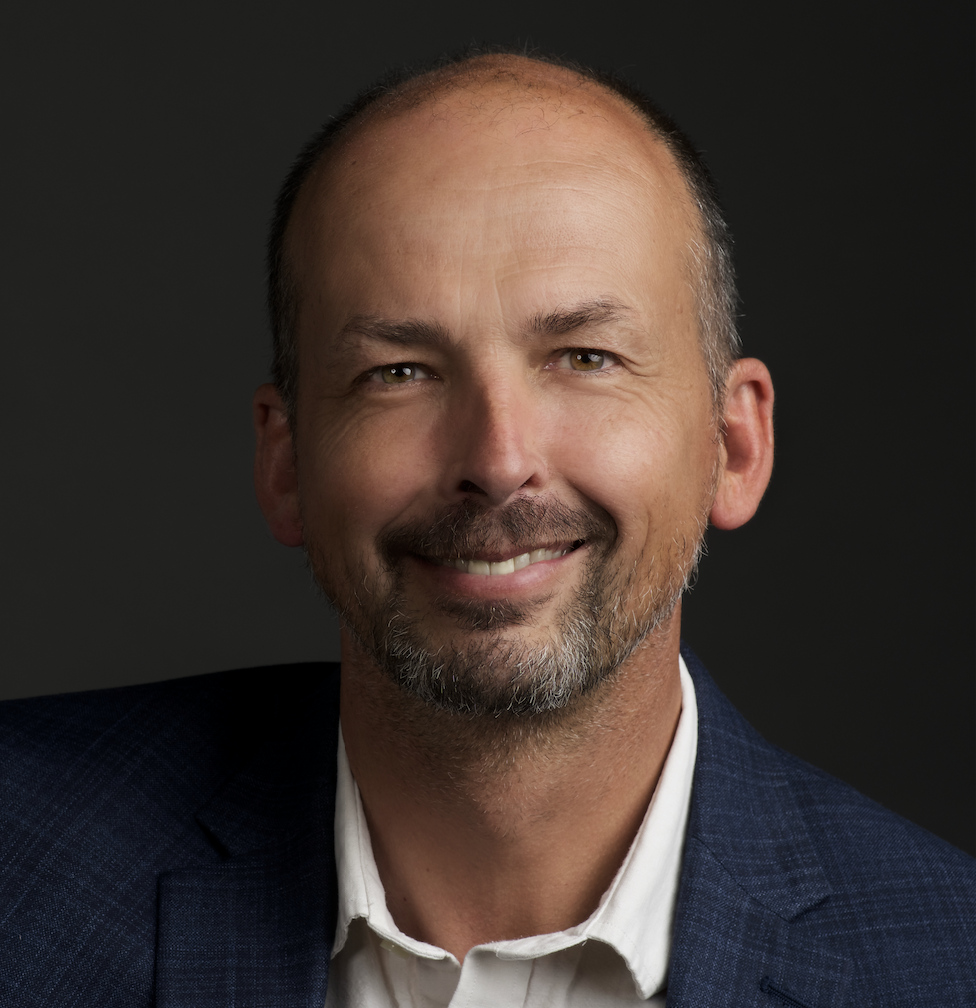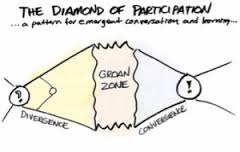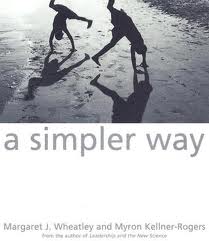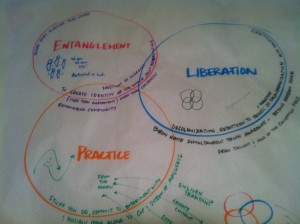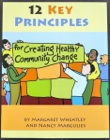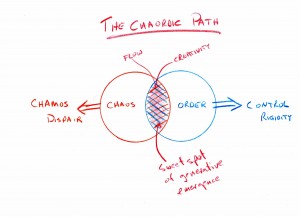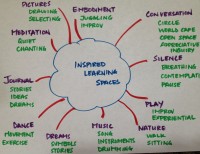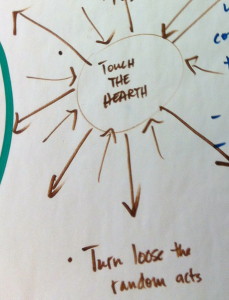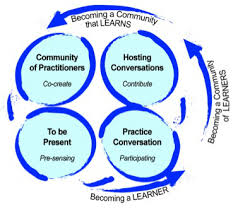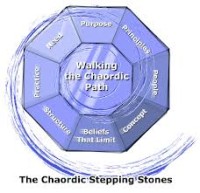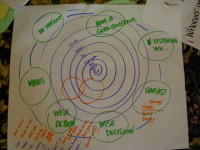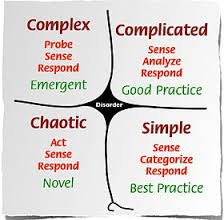Helpful Models / Frameworks
I think of core models and
frameworks as ways of seeing.
They are glasses to try on.
To make visible or clear that which isn’t.
I build varied exercises around these when working with groups. Below is brief description of some that I use most often.
- Divergence and Convergence
- A Simpler Way
- Entanglement, Liberation, and Practice
- Principles for Creating Healthy Community Change
- The Chaordic Path
- Inspired Learning Spaces
- Touch the Hearth
- The Four Fold Practice
- Chaordic Stepping Stones
- Hobbit Tools
- The Cynefin Framework
Divergence and Convergence
This is a way of thinking that I was first introduced to by one of my favorite graduate school professors, Bonner Ritchie. Bonner was the kind of person that had an insatiable curiosity for the new. He would always ask what you were reading. I remember he talked about divergence and convergence as a model for learning. Diverge first. See beyond the known. Follow your interest. Don’t be afraid of messy. Then converge. To something you can apply. He further encouraged me to see that at the end of convergence is invitation to yet another, and often bigger divergence and convergence. One of the stories that I loved from Bonner is how he would practice this learning himself. On occasional weekends, he would put up butcher paper on the walls. He would write, draw, and map everything that he knew and was thinking about. So that he could see the new.
What I like about this model, routed also in the work of Sam Kaner, is that it welcomes a dynamic of living systems. Systems change. They breath. In human systems, this model
maps a way to get from a question,
to some engagement with participative process,
to a groan zone when people don’t know what to do,
to the emergence of ideas that can be put into action.
It is a road map that invites depth and innovation.
Friend, Toke Moeller shares some of this perspective in a 12 minute video from a 2011 training in Halifax, Nova Scotia.
A Simpler Way
The more I work with people, the more I learn that the most likely way to create lasting change is by reclaiming the story that organizations are living systems. It sounds a bit funny even to say that. Lasting change. Perhaps it is the lasting ability to keep changing, keep evolving. Beyond facilitation. Beyond methodologies, important as they are, is the invitation for all of us to reorient ourselves to an adaptive and evolving world. Without the story, it’s like trying to find our way while blindfolded. A Simpler Way is the best version of that story that I know. A Simpler Way is also a title of a book written by my friends Margaret Wheatley and Myron Kellner Rogers, first published in 1996. They were my primary mentors in the early 1990s, the central lineage from which I work. Consider these premises about human organizations from their book — premises that change the starting point of good work together.
The universe is a living, creative, experimenting experience of discovering what’s possible at all levels of scale, from microbe to cosmos.
Life’s natural tendency is to organize. Life organizes into greater levels of complexity to support more diversity and greater sustainability.
Life organizes around a self. Organizing is always an act of creating an identity.
Life self-organizes. Networks, patterns, and structures emerge without external imposition or direction. Organization wants to happen.
People are intelligent, creative, adaptive, self-organizing, and meaning-seeking.
Organizations are living systems. They too are intelligent, creative, adaptive, self-organizing, and meaning-seeking.
Entanglement, Liberation, and Practice
This is a perspective I’ve put together and used more lately. It names three areas of focus for groups, as well as a background story. It is a response to the question, “What are we really doing and what is really going on here, particularly when groups are doing well together?” In short, entanglement is from the quantum perspective that purports a simultaneous state-shift between particles that have come into relationship with each other (entangled) when no longer in the same physical locations. When one changes spin, so does the other simultaneously, seemingly outside of the bounds of times and space. What feels helpful to me as background story is the ways that human beings can become attuned to each other and to the purpose of a project or the direction of a community. Is it possible for humans, sufficiently entangled, to also adapt simultaneously with each other? With this premise, the facilitation I do, is to support such an entanglement. Through sharing stories and questions together. Through play and listening together,
create an identity,
an energetic quality of the whole group
that is much more than agreements and consensus.
I use liberation here to reference a kind of decolonizing or repatterning of our brains and the thoughts and projections that are part of being human. It is about getting free. Or about releasing habit. Even temporarily. There are very practical methods for doing this. One that I find very promising is The Work of Byron Katie. My friend Caitlin Frost is a long term practitioner of this kind of work, helping people to become aware of how engrained individual and collective projections can become. She’s really good at supporting people to see multiple truths simultaneously, rather than more restricted views. The outcome of that, I’ve always found to be very liberating.
Practice here is a reference to what we commit to do from such entanglement and liberation. Tasks. Experiments. Learning commitments. I’ve heard a fair amount of criticism about participative process, stating that it doesn’t lead to enough action. This practice is the action part. There is a difference in what we choose to do with each other when it is assigned compared to emerging from experiences of entanglement and liberation. The former can feel like assignment, void of real commitment and passion. The latter can feel like ease, synergy.
12 Principles for Creating Healthy Community Change
This is part of a kit created by The Berkana Institute. Contained within it are 12 principles for creating change. I’ve also used them as principles for design and principles of freedom when working with core leadership teams. Each principle is accompanied by a few questions to help focus leadership and social engagement. One of the reasons I love these is I feel a deep embodiment of them. I’ve been living in, applying, and learning some form of these principles with many friends through The Berkana Institute since the early 90s.
These principles were created by friends and colleagues, Margaret Wheatley and Nancy Margulies. They are part of an Engaging Community Toolkit created in partnership by The Berkana Institute and Neighborhood Centers Inc. I use working with teams, communities, or movements. They represent a bit of what is underneath choices of engagement methodologies and practices. I introduce the questions as “questions to get started.” They are great for many things including process reflection, staff meetings, setting group norms and agreements, and working with community movements at scale.
The Chaordic Path
It was Dee Hock, former leader of Visa International that coined this phrase, chaordic. It is the place where that natural state of chaos and the natural state of order intersect. Just as it is in the model of divergence and convergence, there is an emergent possibility between the two. A wildly creative place that must have enough chaos and must have enough structure or container for the new to emerge. Notice here, it must have both. Too much chaos tends to lead to apathy. Too much control also leads to a kind of apathy.
In social and engagement processes,
methodologies, questions and overarching purpose
create the container.
It is the unpredictability of social interaction that creates the chaos. New ideas bumping in to one another. New perspectives mixed in a way that will challenge certainty.
There is one further piece that is worth noting here. It was theoretical biologist Stuart Kauffman that I remember writing, “order is for free.” The way that I interpret this is that order does not to be imposed. It is what living systems and living systems of humans do, whether we like it or not. The deeper and more useful question for me is about what kind of order we humans can encourage. What kind of order, without unintentionally stripping the life from what people care about, by imposing unhelpful controls.
For most of us, we have been schooled explicitly in leadership models centered on command and control. We can’t help but feel that loss of control is a bad thing. A weakness. A sign of failure. Personally. Professionally. It’s quite strenuous. What I like about this framing is that it reintroduces us to the ever present place of chaos. Life’s natural fidgeting, letting go, messiness. These are things we have been taught to protect against.
Friend Tim Merry shares some of this in this 6 minute video.
Inspiring Learning Spaces
In the early 2000s Toke Moeller and I talked about these. We named some of what it takes to create good learning together. Since then, I’ve given much thought and practice to developing a wider view of inspired learning spaces. What I love about it is that it looks beyond conversational leadership. Often, from the lineage of The Art of Hosting, there is much focus on conversation as a modality. This is important. It is one of the ways that we humans connect with each other. It is a direct challenge to command and control systems that tend to offer more mandates and dictates, more marching orders than invitations to explore.
As important as the conversations are, and the modalities that support this, I have always felt that there is more that we must attend too. What are the other ways that we find connection with each other? What are other modalities that help a group over time? What is important to help better weave different learning styles or personality types into the room? For me it is important to name that I’m not looking for a bag of party tricks here. When I use any of the activities in this photo, I’m not looking for ice-breakers that are cute to start a meeting. I’m looking for
other modalities that help the people in the room
connect more with each other
and connect more with the multiple layers of purpose
that are present among them.
Touch the Hearth
Cathy Remus is one of my favorite colleagues and people. Her professional life is as a labour educator for CUPE, The Canadian Union of Public Employees. Cathy and I met in early 2008. Myself and two other colleagues hosted a training, staff retreat, and planning session for a group of 30 national labour educators. The short of it is that this process went well. Cathy and her colleagues at CUPE took what they had learned from the experience and spread it across many parts of the labour movement. In speaking with Cathy in early 2014, I was impressed with the way she continued to speak about needing to come back to the source. Come back to the place where it began.
I tend to call this touching the hearth. It is a model for scaling. Come together. Learn. Strength relationships. Do work together. And then go do that work. Not all will move together on all projects. Some will even fall by the way side. This happens if we commit to self-organization and will test many of us on our ability to refrain from digressing to models of control and coercion. However, some will stick. The key is to do the work, then gather again. Touch the hearth again. The source that comes from a group of people huddling together to explore the unknown, ask for the help that they need, and recommit to purpose.
When I think of touching the hearth, I think of coming to a fire. To get warm. To talk. To have some food. There is an energy created in being together. It is relationship centered, but it is not just about relationships. It is as my partner Teresa says, “I don’t know, but we do.” It is as if there is an entity of the whole group that is different that the people that have gathered together. That is a hearth. That is a regeneration, essential in the complex times that we live in.
The Four Fold Practice
This is a teaching that I’ve been using a lot. Each of the circles in this represents what feels like a life-long curriculum to me. And if not life long, they are worth significant time. If it were a post graduate education program, I’d recommend six months on each of these. Each plays off of the other.
When I use this framework I start with Presence. Why? Before we can do anything, we have to be able to show up. Be with others. Be with ourselves. Listen for the unspoken. Look for the unseen. Begin to recognize patterns or create patterns. We have to begin to be able to see together that patterns that no one individual can see by themselves. From there, there is much to putting our presence into practice. How we show up and contribute to conversations. How we invite others to join us. How we co-create useful and helpful information with each other.
There are skills needed at each point along the way.
Chaordic Stepping Stones
I use this primarily as a helpful planning tool. It is called chaordic, from the work of Dee Hock, pointing to the sweet spot between chaos and order and the relationship between the two. I also use this model as a way of charting the landscape when first interacting with a client. It is good to hear the story of what they are up too and what they feel is important. It’s a smart move to pull out a piece of paper and start placing things from the story into these categories:
1. Need (the core story, the nerve, the essence of why a project would matter)
2. Purpose (the need translated into an intention to guide a project)
3. Principles (values that are important to keep a project in integrity)
4. People (participants from the system that can help us learn well together, that can help sustain an on-going effort)
5. Organizational Concept (the beginnings of ideas and format — a meeting, a conference, a series of dialogues, etc.)
6. Limiting Beliefs (engrained thoughts, limits, elephants that will impede full commitment — they are there anyway; might as well bring them to the surface)
7. Structure (next steps, resources that need to be in place, things that move a project along)
8. Practice (thing things we will do and return to with each other — our learning, our relationships, our updates, our requests for help)
If I see that any of these categories are sparse after listening to a clients story, I know where to ask a few more questions. This also serves as a great roadmap for a team or group of people that is in longterm work together.
Hobbit Tools
This is one of my favorite teachings. Playfully named for the
bare bones needed to embark on big adventures,
the simple things you can carry in your pocket. I often teach this at the end of a workshop. It is a marker for simplicity that can be applied at all levels of scale, whether working with self, and individual, a team, or a large scale multi-stakeholder engagement initiative. Though this teaching has been added too in many good ways, it began for me in a conversation with my friend Toke Moeller. We had just finished hosting an event together. I was looking for the simple, the most simple practice that I could apply in many situations. So I asked Toke, “If you had just one tool that you could choose, what would that be?” Presence was his answer. We continued to talk. I asked about a second tool. The result of that conversation is what became for me these hobbit tools. Start with presence. Have a good question. Choose a way to listen together. Harvest. There is much to say and practice in each of these. They are practices for a life time. I love being able to share some stories from each that help ground people and myself in some simple todos.
The Cynefin Framework
Cynefin is a Welsh word meaning “habitat” used by the Welsh Scholar Dave Snowden while working with knowledge management projects at IBM. He offered this framework as a way of seeing how complex systems evolve.
I use this model often, first with a bit of description, then with some embodied experiential exercises, and then with an invitation for people to map their work onto this model. There are typically many “ahas” when making distinctions between the mentality and practice needed in each quadrant. People start to see themselves, their preferred styles. How they interact with colleagues and where some of that is stuck. Blind spots become just a bit visible. Teams get frustrated with each other, particularly in today’s all to common pressure to do more, faster, with less people, and with less resources. This is a framework that seems to help people reorient themselves and their frustration in the reality of today’s complexity. Particularly around the assumption of complex work that is masked as simple and some of the frustration that shows up interpersonally with it.
Further description, including how I’ve used the model is here.
